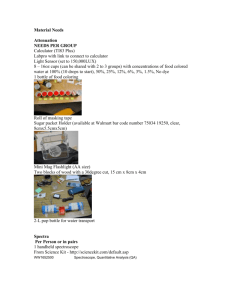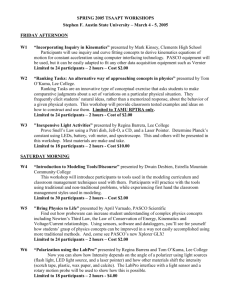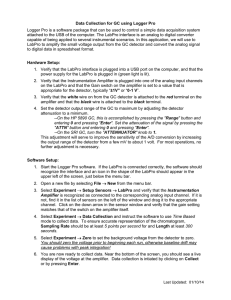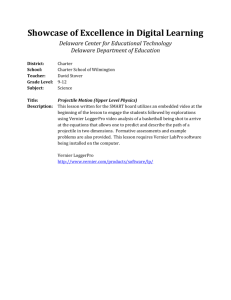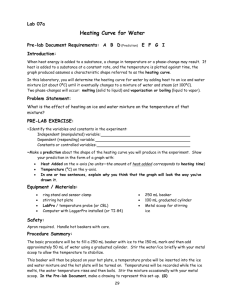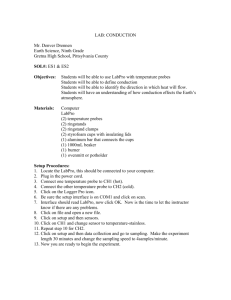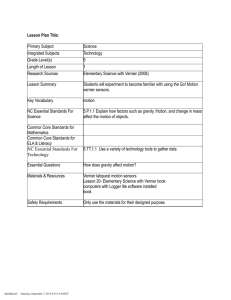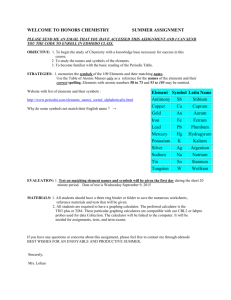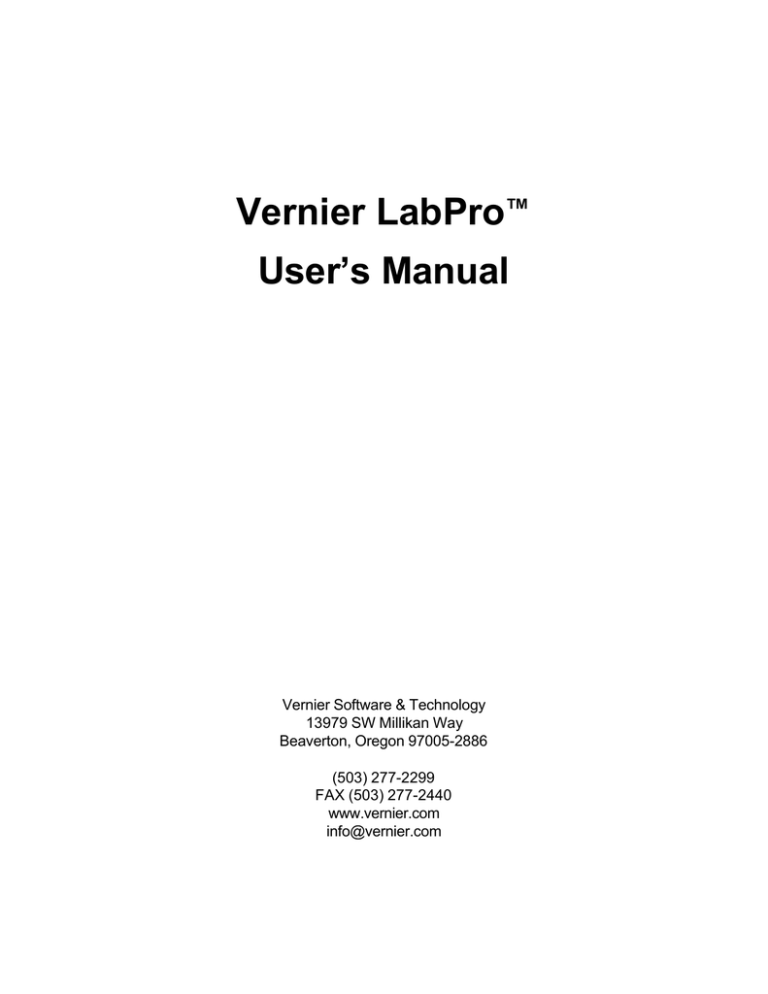
Vernier LabPro™
User’s Manual
Vernier Software & Technology
13979 SW Millikan Way
Beaverton, Oregon 97005-2886
(503) 277-2299
FAX (503) 277-2440
www.vernier.com
info@vernier.com
Vernier LabPro™ User’s Manual Copyright 2000 by Vernier
Software & Technology. All rights reserved. You are entitled to
reproduce parts of this book for use in your school only. No part of
this book may be used or reproduced in any other manner without
written permission of Vernier Software & Technology, except in the
case of brief quotations embodied in critical articles or reviews.
The terms Vernier LabPro and Logger Pro are trademarks of
Vernier Software & Technology. Graphical Analysis is copyrighted
by Vernier Software & Technology. CBL, CBL 2, and TI-GRAPH
LINK are trademarks of Texas Instruments Incorporated. The term
Smart Pulley is a trademark of PASCO scientific. The term
Macintosh is a registered trademark of Apple Computer, Inc.
Windows is registered trademark of Microsoft Corporation.
Published by
Vernier Software & Technology
13979 SW Millikan Way
Beaverton, Oregon 97005-2886
(503) 277-2299
FAX (503) 277-2440
www.vernier.com
info@vernier.com
First Edition 2000
Third Printing
Table of Contents
Introduction.........................................................................................................................1
LabPro Components ........................................................................................................1
BUTTONS ..........................................................................................................................2
LIGHTS..............................................................................................................................2
BEEPS..............................................................................................................................2
Using LabPro with a Computer .......................................................................................3
COMPUTER AND SOFTWARE REQUIREMENTS ...............................................................3
ATTACHING LABPRO TO A COMPUTER ...........................................................................3
PROVIDING POWER TO LABPRO.....................................................................................4
CONNECTING SENSORS ..................................................................................................4
STARTING LOGGER PRO SOFTWARE AND PREPARING TO COLLECT DATA .................5
Tutorial: Temperature Measurement with Logger Pro ..................................................7
Using LabPro with a Calculator .......................................................................................9
CALCULATOR REQUIREMENTS ........................................................................................9
CONNECTING THE EQUIPMENT........................................................................................9
PROVIDING POWER TO LABPRO...................................................................................10
CALCULATOR PROGRAM INSTALLATION ........................................................................10
CONNECTING SENSORS ................................................................................................11
STARTING THE DATA MATE PROGRAM AND PREPARING TO COLLECT DATA ..............11
TUTORIAL: TEMPERATURE MEASUREMENT WITH DATA MATE .....................................13
Using LabPro Remotely .................................................................................................15
USING QUICK SETUP ON LABPRO ................................................................................15
COMPUTER SETUP FOR REAL TIME COLLECT METHOD ..............................................16
COMPUTER SETUP FOR SELECTED EVENTS METHOD ................................................16
REMOTE DATA COLLECTION WITH DATA MATE ............................................................17
Appendix A: Troubleshooting Tips ..............................................................................A-1
Appendix B: Beep Sequences ....................................................................................B-1
Appendix C: Support Materials for LabPro................................................................C-1
SENSORS .....................................................................................................................C-1
ADAPTERS FOR OLDER SENSORS ..............................................................................C-2
ADDITIONAL MANUALS .................................................................................................C-2
Introduction
The Vernier LabPro™ is a versatile data collection interface that can be used to collect data in a
variety of ways in the classroom or in the field. It can be used with a computer, with a TI
Graphing Calculator, or as a stand-alone data logger. More than forty sensors are available,
including an Oxygen Gas Sensor, Relative Humidity Sensor, pH Sensor, Ion Selective
Electrodes, Motion Detector, Accelerometers, etc.
By following this guidebook, you will learn to:
•
•
•
Set up and collect data with a Macintosh™ or Windows™ computer through either the
serial or USB port.
Set up and collect data with a TI-73, TI-82, TI-83, TI-83 Plus, TI-86, TI-89, TI-92, or
TI-92 Plus Texas Instruments Graphing Calculator.
Use LabPro as a stand-alone data logger, and then retrieve data with a computer or a TI
Graphing Calculator.
These procedures are easier and faster than you may think.
LabPro Components
The LabPro package contains all the parts you need to connect LabPro to a computer or TI
Graphing Calculator. Those parts include
•
•
•
•
•
LabPro interface
PC serial cable
Macintosh adapter for serial cable
USB cable
6-volt AC power supply
•
•
•
•
Voltage probe
TI Graphing Calculator cradle
Short calculator-to-calculator link cable
User’s Manual
The LabPro interface has three buttons, three LEDs, four analog channels (CH 1, CH 2, CH 3,
and CH 4), two digital channels (DIG/SONIC 1 and DIG/SONIC 2), a serial computer
connection, a USB computer connection, a piezo speaker, and a calculator I/O port.
Vernier LabPro User’s Manual
1
Buttons
The three buttons on the top of LabPro are used for the following purposes:
•
•
•
TRANSFER begins transfer of calculator programs or applications (apps) between LabPro
and an attached TI graphing calculator.
QUICK SET-UP clears any data stored in LabPro’s memory, then polls all channels for
auto-ID sensors and sets them up to collect data. QUICK SET-UP is used when neither a
computer nor calculator are attached to LabPro and works only with auto-ID sensors.
START/STOP begins sampling for Quick Set-Up. Sampling continues until the default
number of samples is collected or you press START/STOP again. This button also acts as a
manual trigger for certain data-collection modes.
Lights
LabPro has three lights that indicate the LabPro status.
•
•
•
Red indicates an error condition.
Yellow indicates that LabPro is ready to collect data samples.
Green indicates LabPro is collecting data.
Beeps
LabPro has a piezo speaker that makes four kinds of sounds or “beeps”.
•
•
•
•
A “good” beep is a medium tone followed by a high tone.
A “caution” beep is a medium tone followed by another medium tone.
A “bad” beep is a medium tone followed by a low tone.
A “tick” sound is made when a key is pressed.
Appendix B contains a complete description of the conditions that cause these sounds.
2
Vernier LabPro User’s Manual
Using LabPro with a Computer
This section provides the basics for collecting data with LabPro on a Macintosh or Windows
computer. All you have to do is connect LabPro, install the software, attach one or more
sensors, start the Logger Pro™ 2.0 software, and you are ready to collect data.
Computer and Software Requirements
To use LabPro on a computer, you will need Logger Pro 2.0 software1 running on one of the
following computers:
•
•
A Power Macintosh running System 7.6.1 or newer with at least 16 MB RAM, 10 MB
of hard disk space and an unused modem, printer, or USB port.
A Pentium or compatible PC running Windows 95/98/2000 or NT system software
with at least 16 MB RAM, 10 MB of hard disk space and an unused serial or USB
port. (Computers running Windows 3.1 may also work. See the Logger Pro manual for
details.)
Before you continue, check to see that Logger Pro is installed on your computer. If not, now
would be a good time to install it. The Logger Pro User’s Manual describes the software
installation.
Attaching LabPro to a Computer
The LabPro computer connection is located on the right side of the interface. The sliding door
found there can be moved left to reveal the serial port or to the right to reveal the USB port.
Serial Port and Digital Channels (USB Port is behind the sliding door)
Serial Connection to a Macintosh Computer
Attach the rectangular end of the Macintosh serial adapter to the PC serial cable. Plug the round
end of the Macintosh serial adapter into the computer’s modem or printer port. Slide the door
on the computer connection to the left and plug the other end of the serial cable into the serial
connection on LabPro.
USB Connection to a Macintosh Computer
Slide the door on the computer connection to the right and plug the square end of the USB
cable into the LabPro USB connection. Plug the other end of the USB cable into the USB port
on the Macintosh computer.
1
Logger Pro software is available from Vernier Software & Technology for $65 (order code LP).
Vernier LabPro User’s Manual
3
Serial Connection to a PC
Slide the door on the computer connection to the left and plug the round mini-DIN end of the
PC serial cable into the serial connection on LabPro. Plug the other end of the serial cable into
the serial port on the computer.
USB Connection to a PC
Slide the door on the computer connection to the right and plug the square end of the USB
cable into the LabPro USB connection. Plug the other end of the USB cable into the USB port
on the PC.
Providing Power to LabPro
AC power or batteries can power LabPro. To use LabPro with the AC power supply, plug the
round plug on the 6-volt power supply into the side of the interface. Shortly after plugging the
power supply into the outlet, the interface will run through a self-test. You will hear a series of
six beeps and see red, yellow, and green blinking lights indicating a successful power up.
To use LabPro with batteries, remove the battery compartment cover from the underside of the
interface. Insert four AA batteries and replace the compartment cover. Shortly after connecting
to power, the interface will run through a self-test. You will hear a series of six beeps and see
red, yellow, and green blinking lights indicating a successful power up. If the self-test is not
successful, make sure that the batteries are installed correctly and that they are still useable.
Connecting Sensors
Sensors can be divided into two basic types—analog and digital. Examples of analog sensors
are Temperature Probes, pH sensors, Force Sensors, Oxygen Gas Sensors, etc. Up to four
analog sensors can be connected to LabPro. Four jacks for the analog sensors are located on
the same side as the AC Adapter Port. The analog ports accept British Telecom-style plugs
with a right-hand connector.
The tutorial in the next section uses the Vernier Stainless-Steel Temperature Probe. If one of
these probes is available, connect it to channel CH 1.
Examples of digital sensors are Motion Detectors, Radiation Monitors, Photogates, and Rotary
Motion Sensors. Up to two digital sensors can be connected to LabPro. The digital ports
accept British Telecom-style plugs with a left-hand connector. Notice that analog and digital
sensors are “keyed” differently, preventing them from being connected to the wrong port.
Vernier sensors purchased after April 2000 either have a British Telecom connector or they are
shipped with an adapter. These sensors will plug directly into LabPro. You may have older
sensors that you want to connect to LabPro, and they probably can be connected—with the
proper adapter. Most of our older analog sensors have a round 5-pin DIN plug. The DIN-to-
4
Vernier LabPro User’s Manual
BTA adapter (order code DIN-BTA, $5) can be purchased for those sensors. Other sensors
may also be adaptable. See Appendix C or contact us for further details.
Starting Logger Pro Software and Preparing to Collect Data
Locate the Logger Pro icon on your computer and double-click on it, or use the Start menu
(Windows 95/98/2000/NT). An important feature of LabPro is its ability to detect auto-ID
sensors, and automatically set up an experiment.2
The computer will attempt to communicate with LabPro. If you see the following message, then
Logger Pro is having trouble communicating with LabPro. Select the correct port and click
Scan. If this does not work, consult Appendix A.
Windows Setup Interface Dialog Box
Mac Setup Interface Dialog Box
If you have connected a Stainless-Steel Temperature Probe and the computer has detected the
LabPro interface, you will see the following screen, which shows a graph of Temperature vs.
Time.
Notice how the program automatically identified the temperature probe (an auto-ID sensor).
The current temperature reading is displayed in the status bar at the bottom of the screen. The
default data collection mode is time graph. In this example, you have a Temperature Probe,
reading in Celsius, and collecting data as a function of time for 120 seconds. If you now
2
The Vernier lab manuals (see Appendix C) also contain experiment files with sensor and mode settings.
Vernier LabPro User’s Manual
5
disconnect the Temperature Probe, connect a different auto-ID sensor, and choose New from
the File menu, Logger Pro will set up a new experiment for the new sensor.
You are now ready to collect data. The next section is a tutorial that uses our Stainless-Steel
Temperature probe to investigate the response time of the temperature probe. After completing
the tutorial, you may want more detailed information on LabPro or Logger Pro, or you may
want experiments for a particular course. The following manuals provide additional help. They
are described in Appendix C.
Physical Science with Computers
Biology with Computers
Chemistry with Computers
Physics with Computers
Water Quality with Computers
Logger Pro User’s Manual
Logger Pro Tutorials
LabPro Technical Reference Manual
6
Vernier LabPro User’s Manual
Tutorial: Temperature Measurement with Logger Pro
A good way to acquaint yourself with LabPro is by performing a simple experiment. Using this
tutorial, you will take measurements using a temperature sensor. Follow the simple steps and
you are well on your way to collecting and analyzing data with a computer.
MATERIALS
Power Macintosh or Windows PC
LabPro interface
Logger Pro software
Vernier Stainless-Steel Temperature Probe
One 250-mL beaker or cup
100 mL hot water
PROCEDURE
1. Place about 100 mL of hot water into a 250-mL beaker or a cup.
2. Plug the Stainless-Steel Temperature Probe into channel CH 1 on LabPro, and lay the
temperature probe on the tabletop.
3. Start the Logger Pro software. Logger Pro will detect the auto-ID sensor, set the data
collection parameters, and computer display. In this case, collection parameters are 1.0
sample per second and 120 samples. The program displays a graph and data table on the
computer. The vertical axis of the graph will have temperature scaled from 0 to 100°C. The
horizontal axis will have time scaled from 0 to 120 seconds. You are ready to collect data.
4. Click
Collect
to begin data collection.
5. Wait about 10 seconds and place the Temperature Probe into the cup of hot water, as
shown above. Allow Logger Pro to complete data collection.
6. Notice that the sensor does not read the new temperature instantly; it takes a moment to
respond.
7. Now that the run is complete, pull down the Analyze menu and choose Examine. The cursor
will become a vertical line. As you move the cursor across the screen, temperature and time
values corresponding to the cursor position will be displayed. Move the cursor to the point
when the probe was first placed in the hot water. Record that time. Move the cursor to find
the highest temperature, and record that time. How long did it take for the temperature
sensor to stabilize at the water’s temperature?
Vernier LabPro User’s Manual
7
This tutorial is an example of how easy it is to collect and analyze data with LabPro and a
computer. The auto-ID Stainless-Steel Temperature Probe simplified the experiment setup, but
the use of non auto-ID sensors is almost as easy. All you have to do is connect the sensor or
sensors, and open up an appropriate experiment file. Logger Pro software has over 500
experiment files. This set of files also includes experiments from our lab manuals—Biology with
Computers, Chemistry with Computers, Physical Science with Computers, Physics with
Computers, and Water Quality with Computers.
8
Vernier LabPro User’s Manual
Using LabPro with a Calculator
This section provides the basic steps for collecting data with LabPro and a Texas Instruments
Graphing Calculator. All you have to do is connect the hardware pieces to the calculator, attach
one or more sensors, start the DataMate calculator program, and you are ready to collect data.
LabPro Interface, TI-83 Plus Calculator, and Stainless-Steel Temperature Probe
Calculator Requirements
LabPro can be used with any of these TI Graphing Calculators:
•
•
•
•
TI-73
TI-82
TI-83
TI-83 Plus
•
•
•
•
TI-86
TI-89
TI-92
TI-92 Plus
Because of their Flash ROM capabilities, we recommend the TI-73, TI-83 Plus, and TI-89
calculators.
Connecting the Equipment
The first step is to connect the calculator and LabPro.
1.
2.
3.
4.
Insert the upper end of the calculator into the cradle.
Press down on the lower end of the calculator until it snaps into place.
Slide the bottom of the cradle onto the top of LabPro until it clicks in place.
Plug one end of the LabPro-to-calculator cable into the I/O port in the lower end of the
calculator. Plug the other end into LabPro.
Vernier LabPro User’s Manual
9
Providing Power to LabPro
Batteries or AC power can power LabPro. To use LabPro with batteries, remove the battery
compartment cover from the underside of the interface. Insert four AA batteries and replace the
compartment cover. Shortly after connecting to power, the interface will run through a self-test.
You will hear a series of beeps and blinking lights (red, yellow, then green) indicating a
successful power up. If the self-test is not successful, make sure that the batteries are installed
correctly and that they are still useable.
To use LabPro with the AC power supply, plug the round plug on the 6-volt power supply into
the side of the interface. Shortly after plugging the power supply into the outlet, the interface will
run through a self-test. You will hear a series of beeps and blinking lights (red, yellow, then
green) indicating a successful power up.
Calculator Program Installation
When it is time to collect data, you will run a program called DataMate on the calculator.
Chances are that DataMate is not on your calculator, but it is very easy to install.
1. Prepare the calculator to receive the program:
•
For the TI-73, TI-82, TI-83, and TI-83 Plus, turn on your calculator and press 2nd
[LINK] (on the TI-73 press APPS , then select Link…). Press
to RECEIVE, then
press ENTER (Waiting… appears on your screen).
•
For the TI-86, turn on your calculator and press
(Waiting… appears on your screen).
•
For the TI-89, TI-92, and TI-92 Plus, turn on your calculator and make sure that the
calculator is on the Home screen. (You do not need to put the calculator into the
Receiving mode as is required with the other calculators.)
2nd
[LINK], then press
F2
2. Press the Transfer button on LabPro. “Receiving…” followed by a list of the loaded
programs (or application) is displayed on the calculator.
10
Vernier LabPro User’s Manual
3. A “Done” message on the calculator and two beeps from LabPro will indicate the transfer
is complete. Press 2nd [QUIT].
4. Verify that the programs have been successfully loaded.
•
•
•
•
On the TI-73, TI-82, TI-83, press PRGM to see DATAMATE and its subprograms.
On the TI-83 Plus, press APPS to see DATAMATE.
On the TI-86, press PRGM then F1 to see DATAMATE and its subprograms.
On the TI-89, TI-92, and TI-92 Plus, press 2nd [VAR-LINK] to see DATAMATE and
its subprograms.
Connecting Sensors
Sensors can be divided into two basic types—analog and digital. Examples of analog sensors
are Temperature Probes, pH Sensors, Force Sensors, Oxygen Gas Sensors, etc. Up to four
analog sensors can be connected to LabPro. Four jacks for the analog sensors are located on
the same side as the AC Adapter Port. The analog ports accept British Telecom-style plugs
with a right-hand connector.
The tutorial in the next section uses the Vernier Stainless-Steel Temperature Probe. If one of
these probes is available, connect it to channel CH1.
Examples of digital sensors are Motion Detectors, Radiation Monitors, Photogates, and Rotary
Motion Sensors. Up to two digital sensors can be connected to LabPro. The digital ports
accept British Telecom-style plugs with a left-hand connector. Notice that analog and digital
sensors are “keyed” differently, preventing them from being connected to the wrong port.
Vernier sensors purchased after April 2000 either have a British Telecom connector or they are
shipped with an adapter. These sensors plug directly into LabPro. You may have older sensors
that you want to connect to LabPro, and they probably can be connected—with the proper
adapter. Most of our older analog sensors have a round 5-pin DIN plug. The DIN to BTA
adapter (order code DIN-BTA, $5) can be purchased for those sensors. Other sensors may
also be adaptable. See Appendix C or contact us for further details.
Starting the DataMate Program and Preparing to Collect Data
Use the following steps to start the DataMate program on your calculator:
TI-73, TI-82, and TI-83 Calculators :
Press PRGM , then press the calculator key for the number that precedes
1
DATAMATE (usually
). Press ENTER . An introductory screen will
appear, followed by the main screen.
TI-83 Plus Calculators :
Press APPS , then press the calculator key for the number that precedes
DATAMATE. Press ENTER . An introductory screen will appear, followed by
the main screen.
Vernier LabPro User’s Manual
11
TI-86 Calculators :
Press PRGM , press F1 to select < NAMES >, and press the menu key that
represents DataMate. (< DATAM > is usually F1 ). Press ENTER , and wait
for the main screen to load.
TI-89, TI-92, and TI-92 Plus Calculators :
Press 2nd [VAR-LINK]. Use the cursor pad to scroll down to “datamate”,
then press ENTER . Press ) to complete the open parenthesis of
“datamate(” on the entry line. Press ENTER . An introductory screen will
appear, followed by the main screen.
After the program begins, the calculator will try to communicate with the
interface and check for auto-ID sensors. If this communication is successful,
the main screen (shown below) will appear. If the calculator cannot establish a
link with LabPro, this menu appears. If you choose Continue With Interface,
the program will continue trying to communicate with the interface. If the
calculator cannot establish a link with LabPro, a Link Error message will
appear. Check that LabPro has power and that the link cable is properly
connected. This message will continue to appear until the link problem is fixed.
This is the main screen that appears after the calculator and interface are
communicating. In this example a Stainless-Steel Temperature Probe was
connected and DataMate automatically identified the Temperature Probe,
displayed the channel it was connected to and the current reading. DataMate
also sets up a default time graph experiment for auto-ID sensors. In this
example, an experiment was set up to collect data for 180 seconds.
You are now ready to collect data. The next section is a tutorial that uses our Stainless-Steel
Temperature Probe to investigate the response time of the Temperature Probe. After
completing the tutorial, you may want more detailed information on LabPro or DataMate, or
you may want experiments for a particular course. The following manuals provide additional
help. They are described in Appendix C.
Physical Science with Calculators
Biology with Calculators
Chemistry with Calculators
Physics with Calculators
Water Quality with Calculators
LabPro Technical Reference Manual
DataMate Guidebook
12
Vernier LabPro User’s Manual
Tutorial: Temperature Measurement with DataMate
A good way to acquaint yourself with LabPro is by performing a simple experiment. Using this
tutorial you will take measurements using a Temperature Probe. Just follow the simple steps and
you are well on your way to collecting and analyzing data with a calculator.
MATERIALS
TI Graphing Calculator
LabPro interface
DataMate program
Vernier Stainless-Steel Temperature Probe
One 250-mL beaker or cup
100 mL hot water
PROCEDURE
1. Place about 100 mL of hot water into a 250-mL beaker or a cup.
2. Plug the Stainless-Steel Temperature Probe into channel CH 1 on LabPro, and lay the
Temperature Probe on the tabletop.
3. Start the DataMate program. Press CLEAR to reset the program. DataMate will detect the
auto-ID sensor, set the data collection parameters, and display the current sensor reading.
The experiment will collect temperature for 180 seconds.
4. Select START to begin data collection.
5. Wait about 10 seconds and place the Temperature Sensor into the cup of hot water as
shown above. A live graph will appear on the calculator screen. You can either allow
DataMate to complete data collection or press the STO key to stop data collection.
6. After the data collection is complete, an autoscaled graph of the data will appear. Notice
that the probe does not read the new temperature instantly; it takes a little while to respond.
This is a characteristic of the sensor. Use the
or
keys (or the cursor pad on
the TI-92) to examine the data points along the displayed curve of temperature vs. time. As
you move the cursor right or left, the time (X) and temperature (Y) values of each data point
are displayed below the graph. Move the cursor to the point when the probe was first
placed in the hot water. Record that time. Move the cursor to find the highest temperature
and record that time. How long did it take for the temperature sensor to stabilize at the
water’s temperature?
This tutorial is an example of how easy it is to collect and analyze data with LabPro and a TI
Graphing Calculator. The auto-ID Stainless-Steel Temperature Probe simplified the experiment
setup, but the use of non auto-ID sensors is easy too. All you have to do is select SETUP on
Vernier LabPro User’s Manual
13
the main screen of DataMate. This will take you to the Setup screen. From here you can set up
non auto-ID sensors and make changes to the data collection mode. Complete details on these
procedures can be found in the DataMate Guidebook.
Full sets of experiments are available in our lab manuals—Biology with Calculators,
Chemistry with Calculators, Physical Science with Calculators, Physics with Calculators,
and Water Quality with Calculators.
14
Vernier LabPro User’s Manual
Using LabPro Remotely
LabPro can collect data without being attached to a computer or calculator. Having a computer
or calculator attached to LabPro is preferable, because it provides much more flexibility in your
data collection and provides a screen for immediate feedback of your results. There are times,
however, when disconnecting the computer or calculator from LabPro to collect data is useful.
For example, remote data collection is perfect for gathering acceleration data on a roller
coaster. There are three ways that LabPro can be used by itself to collect data:
•
•
•
Using the Quick Setup feature of LabPro and auto-ID sensors, sensors can be set up and
data collected without being attached to a computer or graphing calculator. After the
experiment is done, either the computer or the calculator can retrieve the data.
The computer can set up LabPro for remote data collection. LabPro can be removed from
the computer for data collection, then reattached to the computer for data retrieval. The
computer method also allows you to use sensors that are not auto-ID. You can also use the
Selected Event data collection mode.
The graphing calculator can set up LabPro for remote data collection. LabPro can be
removed from the calculator for data collection, then reattached to the calculator for data
retrieval.
Using Quick Setup on LabPro
The Quick Setup feature is very simple:
1. Set up LabPro for remote data collection.
a. Connect your auto-ID sensor(s) to LabPro. (Sensors that are not auto-ID cannot be
used with this method. The next two methods allow you to use auto-ID and/or non autoID sensors.)
b. Press the QUICK SETUP button. The yellow LED will blink twice and two beeps will be
heard verifying setup.
2. Collect data.
a. When you are ready to collect data, press the START/STOP button. The green LED will
flash during data collection.
b. When data collection is complete, the green LED will stop blinking.3 You do not need to
press the START/STOP button to end data collection. (You can, however, stop data
collection early by pressing the START/STOP button before data collection is finished.)
3. Retrieve the data.
With a computer,
a.
b.
c.
d.
3
Start Logger Pro (if it is not already running).
Select Retrieve Data from LabPro from the Remote menu.
Connect LabPro to the computer.
The data will be transferred from LabPro into Logger Pro. The labels and the units in the
column headings and on the graph may need to be changed to match the sensor.
The duration of data collection will vary from sensor to sensor.
Vernier LabPro User’s Manual
15
With a calculator,
a. You can retrieve the data by connecting the interface to a TI Graphing Calculator and
starting DataMate. A message will appear stating “DATA COLLECTION IS DONE. . .”
b. Press ENTER to proceed to the main screen.
c. Select TOOLS from the main screen.
d. Select RETREIVE DATA from the TOOLS menu. The data will be retrieved and one or
more graphs made available.
Computer Setup for Real Time Collect Method
Using the Setup for Real Time Collect Method, you will use a computer to set up LabPro,
detach it for a real time data collection, then reattach it to the computer to retrieve the data. This
gives you more flexibility than the Quick Setup Method. With this method, you can (a) use any
sensors (not just auto-ID), (b) control the time between samples, and (c) control the number of
data points collected (up to 12,000).
1. Set up LabPro for remote data collection
a. Set up the sensors, LabPro, and Logger Pro just as you normally would to collect data
in Real Time Collect mode.
b. Be sure to save this setup in an experiment file.
c. Instead of clicking the Collect button, select Set Up LabPro from the Remote menu.
d. Follow the on-screen instructions to finish setup.
e. Click the Setup button. The yellow LED on LabPro will come on, indicating that it is
ready to collect data.
f. Disconnect LabPro from the computer. If appropriate, exit the Logger Pro program.
2. Collect data.
a. When you are ready to collect data, press the START/STOP button. The green LED will
flash each time a reading is made.
b. When data collection is complete, the green LED will stop blinking. You can, however,
stop data collection early by pressing the START/STOP button before data collection is
finished.
3. Retrieve the data.
a. Connect LabPro to a computer.
b. Start the Logger Pro software. A dialog box labeled “LabPro Has Data” will appear.
c. Click the Open Experiment button, and open the experiment file you used in setting up
the remote experiment.
d. Click the Retrieve Data button on the dialog box.
e. The data will be transferred from LabPro into Logger Pro.
Computer Setup for Selected Events Method
Using the Setup for Selected Events Method, you will use a computer to set up LabPro, detach
it to collect individual data points, then reattach it to retrieve the data. With this method, you can
use any sensors (not just auto-ID), and collect individual data points whenever you press the
START/STOP button.
16
Vernier LabPro User’s Manual
1. Set up LabPro for remote data collection
a. Set up the sensors, LabPro, and Logger Pro just as you normally would to collect data
using the Selected Events mode.
b. Be sure to save this setup in an experiment file.
c. Instead of clicking the Collect button, select Set Up LabPro from the Remote menu.
d. Follow the on-screen instructions to finish setup.
2. Collect data.
a. Every time you press the START/STOP button, LabPro will collect one data point. Up to
99 data points can be collected.
3. Retrieve the data.
a. Connect LabPro to a computer.
b. Start the Logger Pro software. A dialog box labeled “LabPro Has Data” will appear.
c. Click the Open Experiment button, and open the experiment file you used in setting up
the remote experiment.
d. Click the Retrieve Data button on the dialog box.
e. The data will be transferred from LabPro into Logger Pro.
Remote Data Collection with DataMate
This method gives you more control of the data collection than the Quick Setup method,
because you have control of which sensors and what data collection sample interval will be
used. This is how it works:
1. Attach one or more sensors to LabPro. These sensors can be auto-ID or non auto-ID
sensors.
2. Start the DataMate program. The program will detect auto-ID sensors. Non auto-ID
sensors can be set up manually. (Refer to the DataMate Guidebook for help.)
a.
b.
c.
d.
Select SETUP from the main screen.
Press
to select MODE and press E N T E R .
Select TIME GRAPH from the SELECT MODE menu.
Select CHANGE TIME SETTINGS from the TIME GRAPH SETTINGS menu to set the data
collection rate.
e. Enter the time between samples in seconds (remember to finish your entry with E N T E R ).
f. Enter the number of samples.
3. Set up the interface for manual triggering.
a.
b.
c.
d.
Select ADVANCED from TIME GRAPH SETTINGS .
Select CHANGE TRIGGERING from ADV. TIME GRAPH SETTINGS .
Select MANUAL from SELECT TRIGGERING.
Select OK three times to return to the main screen.
4. Select START to prepare LabPro for data-collection. The yellow light will come on, two
beeps will be made, and a message will appear stating that remote data collection has been
set up.
5. Press ENTER to return to the main screen and choose Quit.
Vernier LabPro User’s Manual
17
6. Disconnect LabPro from the calculator. To start data collection, press the START/STOP
button on LabPro. The yellow light will go off and the green light will blink during data
collection.
7. When the green LED stops blinking and data collection is done, attach LabPro to the same
calculator and start the DataMate program. The program will detect that data has been
collected by LabPro and will display a message about retrieving the data. Press ENTER on
the calculator. On the main screen, select TOOLS, and then select RETRIEVE DATA on the
TOOLS menu. The data will be retrieved and one or more graphs made available.
18
Vernier LabPro User’s Manual
Appendix A: Troubleshooting Tips
Problem
Cause/Solution
When LabPro is used with the
computer, the Logger Pro
Collect button does not appear.
The Collect button does not appear because the computer
could not communicate with the interface. Check each of
the following:
• Make sure the cables are firmly attached.
• Make sure LabPro is connected to the correct port on
the computer.
• Confirm that the port on the computer is working
properly.
Make sure the interface has power—either AC or battery.
When LabPro is used with a TI
Graphing Calculator, a link
error message will not go away.
This message appears when the calculator cannot
communicate with the interface. Check each of the
following:
• Make sure the cables are firmly attached to the calculator
and LabPro.
• Make sure the interface has power—either AC or
battery.
The sensor is not working.
This may be happening because the sensor is not plugged
into the correct port. Since LabPro has 4 analog and 2
digital ports, make sure that the sensor is connected to the
proper port.
The readings are noisy.
LabPro may be picking up interference from other electrical
devices, such as a computer. Move the LabPro interface at
least 30 cm from another computer.
When LabPro is plugged into
AC power, the lights and beeps
are not generated.
When LabPro powers up, lights and beeps signal a
successful self-test. If batteries are already installed in
LabPro, the self-test will not be performed.
When connected to USB, a
light can be seen blinking inside
the interface.
This is normal operational when LabPro is used through a
USB port.
Vernier LabPro User’s Manual
A-1
Appendix B: Beep Sequences
LabPro makes four kinds of sounds or “beeps”:
• A “good” beep is a medium tone followed by a high tone.
• A “caution” beep is a medium tone followed by another medium tone.
• A “bad” beep is two high tones.
• A “tick” sound is made when a key is pressed.
The following bullets explain when beep sequences occur and what the beep sequences mean.
• When LabPro completes initialization, you will hear the startup sequence: bad beep, caution beep,
good beep (6 total beeps, plus LEDs light up in this order: red LED, yellow LED, and green
LED)
• When you press the QUICK SETUP button:
− the caution beep sounds if a sensor is attached to LabPro.
− the bad beep sounds if no sensors are attached to LabPro.
• When LabPro is connected to a calculator during sampling commands:
− the caution beep sounds when initializing data collection.
− the caution beep sounds when starting data collection (transition from pre-store to
store).
− the caution beep sounds when completing data collection.
Note 1: If the sampling timing causes the beeps to run together, the LabPro software may not
sound all the beeps.
Note 2: You will not get all the beeps when Fast Sampling is enabled.
Note 3: You will not get all the beeps when using triggering.
• When you set LabPro for manual trigger and press the START button, a caution beep sounds.
• When you press the TRANSFER button:
− the good beep sounds when the transfer succeeds.
− the bad beep sounds if the transfer fails for any reason.
• When an overcurrent condition is detected, five bad beeps sound. (This causes an error, which
causes even more beeps to sound.)
• When LabPro begins a full self-test, three good beeps sound.
• When self-test completes:
− the good beep sounds if self-test passes.
− the bad beep sounds if self-test fails.
• When LabPro’s base code detects an error in the commands sent from the host, a bad beep
sounds twice.
• When LabPro powers up:
− two bad beeps sound if the base code is not loaded.
− three bad beeps sound if the power-up self-test fails.
•
During base code download, three bad beeps sound when any errors occur. (The unit resets
and then the two bad beeps mentioned in the previous bullet sound.)
Vernier LabPro User’s Manual
B-1
Appendix C: Support Materials for LabPro
Sensors
Over forty different sensors can be used with LabPro. They include:
Sensor/Probe
3-Axis Accelerometer
25-g Accelerometer
Low-g Accelerometer
Barometer
CO2 Gas Sensor
Colorimeter
Conductivity Probe
Current & Voltage Probe System
Digital Control Unit
Dissolved Oxygen Probe
Dual-Range Force Sensor
EKG Sensor
Exercise Heart Rate Monitor
Extra Long Temperature Probe
Gas Pressure Sensor
Heart Rate Monitor
Flow Rate Sensor
Instrumentation Amplifier
Ammonium Ion-Selective Electrode
Calcium Ion-Selective Electrode
Chloride Ion-Selective Electrode
Nitrate Ion-Selective Electrode
Light Sensor
Magnetic Field Sensor
Microphone
Motion Detector
O2 Gas Sensor
pH Sensor
Radiation Monitor
Relative Humidity Sensor
Respiration Monitor Belt
(requires GPS-BTA or BGP-DIN)
Rotary Motion Sensor
Stainless Steel Temperature Probe
Student Force Sensor
Student Radiation Monitor
Turbidity Sensor
Thermocouple
Vernier Photogate
Voltage Probe
Vernier LabPro User’s Manual
Order Code
3D-BTA
ACC-BTA
LGA-BTA
BAR-BTA
C02-BTA
COL-BTA
CON-BTA
CV-BTA
DCU-BTD
DO-BTA
DFS-BTA
EKG-BTA
EHR-BTA
TPL-BTA
GPS-BTA
HRM-BTA
FLO-BTA
INA-BTA
NH4-BTA
CA-BTA
CL-BTA
NO3-BTA
LS-BTA
MG-BTA
MCA-BTA
MD-BTD
O2-BTA
PH-BTA
RM-BTD
RH-BTA
RMB
Price
$199
$91
$90
$58
$261
$99
$81
$86
$61
$191
$99
$142
$91
$70
$71
$49
$129
$51
$165
$165
$165
$165
$45
$46
$35
$64
$186
$74
$205
$67
$58
RMS-BTD
TMP-BTA
SFS-BTD
SRM-BTD
TRB-BTA
TCA-BTA
VPG-BTD
VP-BTA
$187
$29
$99
$145
$99
$37
$41
$9
C-1
Adapters for Older Sensors
Vernier sensors purchased prior to the introduction of LabPro can probably be adapted to
work with LabPro. Most of our analog sensors were previously manufactured with a round, 5pin “DIN” plug. If you have one of these older DIN sensors, you will need a DIN-to-BTA
adapter (order code DIN-BTA, $5). This chart shows some of the adapters that can be used
with other sensors. You may have sensors that do not appear in this table. Contact us to discuss
your situation.
Sensors Purchased Prior to 2000
Adapter
Order Code, Price
DIN to BTA adapter
DIN-BTA, $5
LabPro Digital Adapter
DG-BTD, $5
Older ULI Motion Detector
CBL-RJ11 Adapter
CBL-RJ11, $5
New ULI Motion Detector
LabPro/CBL Motion Detector cable
CBL-MDC, $5
Rotary Motion Adapter
ROT-BTD, $5
Vernier Analog 5-pin DIN sensors
Vernier Assembled Photogate, Smart
Pulley™, Radiation Monitors
Rotary Motion Sensor
Additional Manuals
There are a number of additional manuals that can help you use LabPro with a computer or
calculator.
LabPro Technical Reference – The reference provides detailed information on the LabPro
hardware and the software command structure. This manual is available free from our web site,
www.vernier.com.
Logger Pro Tutorials – This manual provides an excellent introduction to the Logger Pro
software. The tutorials show you how to collect data with a Temperature Probe and a Motion
Detector. It also introduces you to the analysis features of the program.
Logger Pro User’s Manual – This manual is a complete reference to the software. This manual
and the Logger Pro Tutorials are a part of the Logger Pro package. The User’s Manual can
also be found on the Logger Pro software CD.
DataMate Guidebook – This guidebook provides a complete look at the DataMate calculator
program. This manual can also be downloaded from our web site, www.vernier.com.
Lab Manuals - Lab manuals in physical science, biology, chemistry, physics and water quality
enable you and your students to quickly begin using LabPro in the classroom and in the field.
Each manual contains
•
•
•
C-2
Ready-to-use student experiments.
Teacher section for each experiment with complete directions, helpful hints, and sample
graphs and data.
Word processing files of the student sections on CD, so labs may be edited to your
specifications.
Vernier LabPro User’s Manual
Physical Science with Computers .........PSC-LP .......$35
Physical Science with Calculators ........PSCALC......$35
Some of the experiments are
•
Energy Content of Foods and Fuels
•
Reflectivity of Light
•
Acid Rain
First-Class Levers and Pulleys
Lemon “Juice”
Graphing Your Motion
•
•
•
Biology with Computers........................BWC-LP......$35
Biology with Calculators.......................BWCALC....$35
Some of the experiments are
•
Diffusion through Membranes
•
Transpiration
•
Biological Membranes
Cellular Respiration
Photosynthesis
Watershed Testing
•
•
•
Chemistry with Computers ...................CWC-LP .....$35
Chemistry with Calculators ..................CWCALC....$35
Some of the experiments are
•
Vapor Pressure of Liquids
•
Hess’s Law
•
Determining the Concentration of a Solution
•
•
•
Conductivity of Saltwater
Acid-Base Titration
Pressure-Temperature Relationship in Gases
Physics with Computers........................PWC-LP ......$35
Physics with Calculators.......................PWCALC ....$35
Some of the experiments are
•
Newton’s Second Law
•
Bungee Jump Accelerations
•
Projectile Motion
•
Sound Waves and Beats
•
Ohm’s Law
•
Accelerations in the Real World
Water Quality with Computers .............WQC-LP .....$35
Water Quality with Calculators ............WQCALC ...$35
Some of the experiments are
•
Total Solids
•
BOD
•
Fecal Coliform
•
Ammonium Nitrogen
Vernier LabPro User’s Manual
•
•
•
•
Dissolved Oxygen
Phosphates, Ortho- and Total
Nitrate
Stream Flow
C-3

